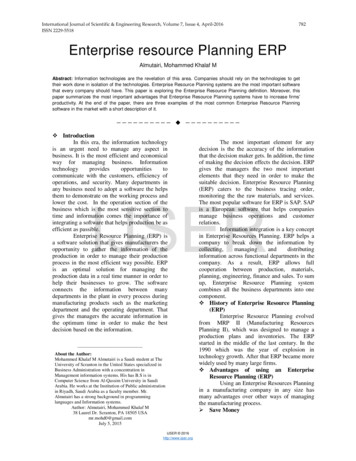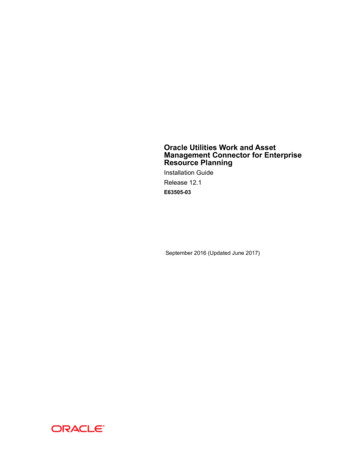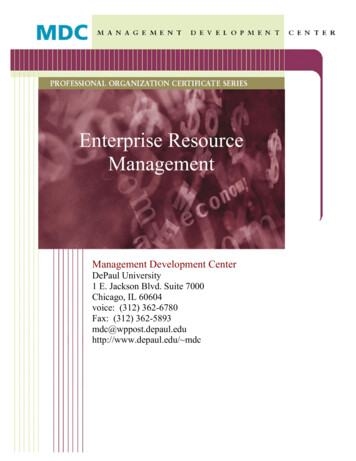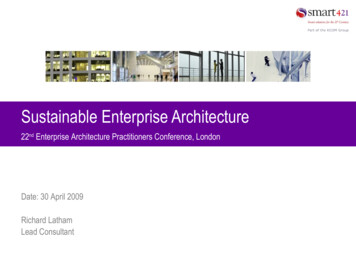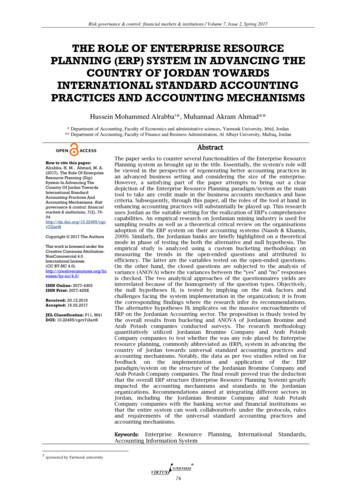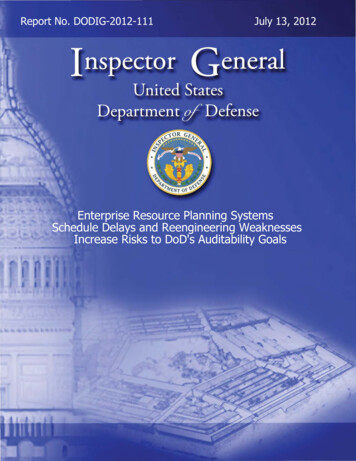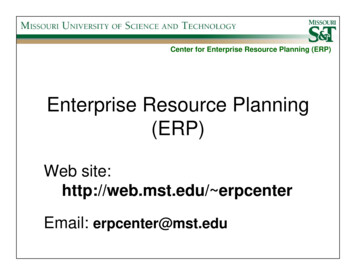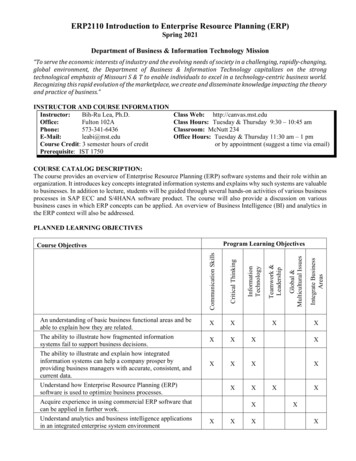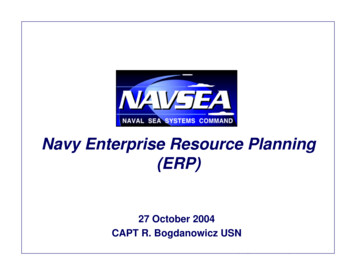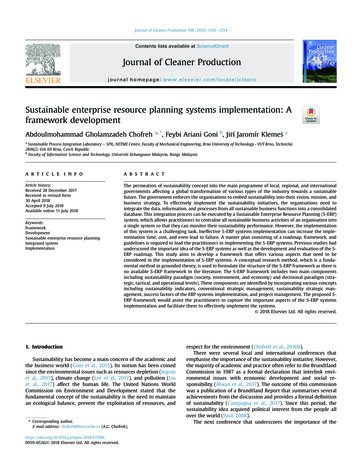
Transcription
Journal of Cleaner Production 198 (2018) 1345e1354Contents lists available at ScienceDirectJournal of Cleaner Productionjournal homepage: www.elsevier.com/locate/jcleproSustainable enterprise resource planning systems implementation: Aframework developmentAbdoulmohammad Gholamzadeh Chofreh a, *, Feybi Ariani Goni b, Ji rí Jaromír Kleme s aa Sustainable Process Integration Laboratory e SPIL, NETME Centre, Faculty of Mechanical Engineering, Brno University of Technology - VUT Brno, Technicka2896/2, 616 69 Brno, Czech RepublicbFaculty of Information Science and Technology, Universiti Kebangsaan Malaysia, Bangi, Malaysiaa r t i c l e i n f oa b s t r a c tArticle history:Received 28 December 2017Received in revised form30 April 2018Accepted 9 July 2018Available online 11 July 2018The permeation of sustainability concept into the main programme of local, regional, and internationalgovernments affecting a global transformation of various types of the industry towards a sustainablefuture. The government enforces the organisations to embed sustainability into their vision, mission, andbusiness strategy. To effectively implement the sustainability initiatives, the organisations need tointegrate the data, information, and processes from all sustainable business functions into a consolidateddatabase. This integration process can be executed by a Sustainable Enterprise Resource Planning (S-ERP)system, which allows practitioners to centralise all sustainable business activities of an organisation intoa single system so that they can monitor their sustainability performance. However, the implementationof this system is a challenging task. Ineffective S-ERP systems implementation can increase the implementation time, cost, and even lead to failure. A master plan consisting of a roadmap, framework, andguidelines is required to lead the practitioners in implementing the S-ERP systems. Previous studies hadunderscored the important idea of the S-ERP systems as well as the development and evaluation of the SERP roadmap. This study aims to develop a framework that offers various aspects that need to beconsidered in the implementation of S-ERP systems. A conceptual research method, which is a fundamental method in grounded theory, is used to formulate the structure of the S-ERP framework as there isno available S-ERP framework in the literature. The S-ERP framework includes two main componentsincluding sustainability paradigm (society, environment, and economy) and decisional paradigm (strategic, tactical, and operational levels). These components are identified by incorporating various conceptsincluding sustainability indicators, conventional strategic management, sustainability strategic management, success factors of the ERP systems implementation, and project management. The proposed SERP framework would assist the practitioners to capture the important aspects of the S-ERP systemsimplementation and facilitate them to effectively implement the systems. 2018 Elsevier Ltd. All rights reserved.Keywords:FrameworkDevelopmentSustainable enterprise resource planningIntegrated systemImplementation1. IntroductionSustainability has become a main concern of the academic andthe business world (Goni et al., 2015). Its notion has been coinedsince the environmental issues such as resources depletion (Ingraoet al., 2017), climate change (Lee et al., 2017), and pollution (Liuet al., 2017) affect the human life. The United Nations WorldCommission on Environment and Development stated that thefundamental concept of the sustainability is the need to maintainan ecological balance, prevent the exploitation of resources, and* Corresponding author.E-mail address: chofreh@fme.vutbr.cz (A.G. .0960959-6526/ 2018 Elsevier Ltd. All rights reserved.respect for the environment (Chofreh et al., 2016b).There were several local and international conferences thatemphasise the importance of the sustainability initiative. However,the majority of academic and practice often refer to the BrundtlandCommission in 1987 as a formal declaration that interlink environmental issues with economic development and social responsibility (Alwan et al., 2017). The outcome of this commissionwas a publication of a Brundtland Report that summarises severalachievements from the discussion and provides a formal definitionof sustainability (Campagna et al., 2017). Since this period, thesustainability idea acquired political interest from the people allover the world (Paul, 2008).The next conference that underscores the importance of the
1346A.G. Chofreh et al. / Journal of Cleaner Production 198 (2018) 1345e1354sustainability concept is the Rio Earth Summit in 1992. Paul (2008)mentioned that this conference is considered the largest historicalevent held by the United Nations, which gathered 10,000 representatives from 178 countries. The main results of this conferencewere the Commission on Sustainable Development, Rio Declaration, and Agenda 21, which underscored the critical issues in sustainability and collect an agreement of leaders to move towardssustainable future (Paul, 2008). This event is the root of a globalbusiness transformation to deliver significant sustainability outcomes through an embedment of sustainability into the government programmes and regulations in national, regional, andinternational levels (Goni et al., 2017).Enforcement of government regulations to integrate sustainability into business practices and increasing customer demand forsustainable products force the organisations to change theirmethod of doing business (Stafford-Smith et al., 2017). They need toincorporate the sustainability initiatives into their business functions and activities to achieve sustainable outcomes (Goni et al.,2013b). Melville and Whisnant (2012) stated that effective sustainability implementation and valid sustainability reports entailaccurate and reliable data and information. However, the sustainability reporting activities and its performance evaluation are stillmanually managed using spreadsheets. This technique is noteffective and efficient when the practitioners need to provide afrequent basis report to the stakeholders. As sustainability becamea key aspect of strategy and operations, the emergence of a newgeneration of enterprise systems would advance the businessprocesses (Chofreh, 2015). The management of sustainability data,processes, and reporting need to be integrated into SustainableEnterprise Resource Planning (S-ERP) systems, which enable thepractitioners to coordinate the sustainable business activities(Odenwald and Berg, 2014). The S-ERP system simplifies the datacollection, calculation, evaluation, and reporting processes acrosssustainable business functions (Chofreh et al., 2014a).The implementation of the S-ERP systems is favourable for organisations; however, it needs a broad endeavour as well as multiple skills and knowledge. The practitioners require having aholistic plan that guides them to implement the system. In the firstpart of the study, Chofreh et al. (2016a) had presented an S-ERPmaster plan concept that shows a strategic plan and action toimplement the S-ERP systems. It comprises of three interlockingcomponents including a roadmap, framework, and guidelines. Theroadmap provides process groups to complete the S-ERP implementation. The framework offers numerous aspects that need to beincluded in the system implementation. The guidelines providesequential activities that need to be executed throughout the system implementation.The design of the S-ERP roadmap has been formulated byChofreh et al. (2017a) in the second part of the study adapting theproject management concept. As an outcome, the roadmap comprises of three phases including pre-implementation, implementation, and post-implementation. Chofreh et al. (2017b)validated the content of the S-ERP roadmap using experts' review, which is the third part of studies. They found that the initialstructure of the S-ERP roadmap needs to be reformed. It needs to bedivided into two main parts including sustainable enterprise andsustainably integrated enterprise roadmaps. The sustainable enterprise roadmap concerning the process groups to transform anorganisation from unsustainable to the sustainable organisation.The sustainably integrated enterprise roadmaps concerning theprocess groups that need to be completed to achieve a sustainablyintegrated organisation.The fourth part of the study is completing the formulation of theS-ERP master plan concerns on the development of an S-ERPframework. This study would target to answer a question of “Whatare the aspects that need to be considered in the implementation ofthe S-ERP systems. To answer the research question, a conceptualresearch method is used to design the structure of the framework.This method emphasises on the literature review to build a newconcept. In this regard, four research areas are examined: (i) sustainability implementation frameworks, (ii) Enterprise ResourcePlanning (ERP) implementation framework, (iii) decisional paradigm, and (iv) project management. The analysis revealed that theS-ERP framework comprises two main perspectives including sustainability (environment, economic, and social) and decisional(strategy, tactic, and operation) paradigms.2. Literature reviewChofreh et al. (2016c) claimed that the implementation of the SERP systems is not trivial and it needs a considerable effort toaccomplished. The process involves a wide range of knowledgecovering managerial and technology. Practitioners require a holisticframework to ascertain the important aspects of the S-ERP system.To obtain the holistic framework, the present study investigatesfour related research fields containing sustainability implementation frameworks, ERP implementation frameworks, decisionalparadigm, and project management. The literature analysis of thesefour areas is presented in the following sub-sections.2.1. Sustainability implementation frameworkResearch interests in the sustainability area have been significantly growing. A number of studies have investigated the sustainability implementation from various viewpoints, such assustainability reporting (Ahmed and Sundaram, 2012), ProcessIntegration (Chofreh et al., 2014a), sustainability implementation inhigher educations (Goni et al., 2017), supply chain (Bendul et al.,2016), and operations (Font, 2017). Different research perspectives have different approaches, strategies, and methodologies tosolve the problem and the phenomena under investigation. Ingetting a general idea to develop the S-ERP framework, the presentstudy examines numerous existing studies that highlight thedevelopment of sustainability implementation frameworks fromvarious viewpoints. This technique is convenient since there arelimited studies that observe the S-ERP system implementation.British Standards Institution (BSI) (2003) introduced a management framework for the implementation of sustainability inorganisations. They argued that the sustainability implementationmeans embedding sustainability into the primary business processes in order to improve and preserve five capitals includingnatural, human, financial, social, and manufactured capitals. Burkeand Gaughran (2007) developed a framework for managing sustainability in small manufacturing companies. The outcomes of thecase study revealed that the top management support and contribution of all staffs are the key aspect of successful sustainabilitymanagement in organisations. The framework was valuable for thepractitioners in enhancing the efficiency of operations. Loorbachet al. (2009) introduced a conceptual framework to manage thebusiness transition from unsustainable organisations towardssustainable organisations. They claimed that the transition processneeds persistent process and structural alterations in culture,technology, economy, and organisational aspects. They used atransition management and complex systems theories, then, relateit to the government policy to formulate the framework.Ahmed and Sundaram (2012) introduced an integrated framework as a part of the sustainability transformation systems forimplementing the sustainability reporting. In the analysis, theyused various concepts, such as sustainability systems and businessprocess engineering, to provide an integrated approach that links
A.G. Chofreh et al. / Journal of Cleaner Production 198 (2018) 1345e1354the sustainability modelling to the sustainability reporting. Hahnet al. (2015) introduced a systematic framework to manage thetensions in sustainability implementation. They argued that thesustainability implementation need s to be seen as an integrativeprocess in which the sustainability dimensions (environmental,social, and economic) need to be integrated simultaneously at alllevels of an organisation. They found that the framework shouldhave three main aspects including context, change, and level. Thisframework was then used to analyse the tensions emerged duringthe sustainability transformation. Panagiotakopoulos et al. (2016)analysed a Viable System Model (VSM) framework introduced bya manufacturing company to align the sustainability standards withthe business process of an organisation. The development of theVSM framework adopted the viable system model theory. It contains three main aspects including environment, management, andoperations. The authors analysed the content and relationship between elements of the framework. Nawaz and Koç (2018) proposeda conceptual framework for managing the sustainability transformation at the organisational level. They claimed that the proposed framework is valuable as it involves numerous importantaspects, such as stakeholders, transparency, and assessment systems. Table 1 presents a summary of the literature analysis.2.2. ERP implementation frameworkEnterprise Resource Planning (ERP) is the basis of the S-ERPsystems in which its implementation is critical for organisations.The experience of ERP systems implementation can be applied in SERP systems implementation since their general idea is similar.Goni et al. (2013a) stated that the ERP systems implementationrequires support by the top managers of an organisation andcommitment by the project team to ensure success. A comprehensive plan, which identifies all the requirements and importantaspects, is necessary for successful ERP systems implementation.The ERP systems research has been steadily growing since 2000(Sadrzadehrafiei et al., 2013). Its research streams were scatteredinto various subjects, such as success and failure factors, organisational readiness assessment, systems implementation, and systems evaluation. There are numerous studies proposing aframework for successful ERP systems implementation in organisations. Al-Mashari et al. (2003) introduced an ERP framework bycombining the critical success factors with the implementationactivities. They argued that the ERP benefits can be realised byaligning the technical and managerial capabilities in the implementation process. The proposed framework provided theseimportant capabilities and reflected the essential aspects of ERPsystems. Zhang et al. (2005) developed a framework for successfulERP systems implementation in China. They adapted numerousexisting frameworks from various related studies for the1347formulation of the framework. The relationship between variablesin the developed framework was then assessed using a case studymethod.Sahran et al. (2010) proposed a framework for the implementation of ERP systems in small and medium organisations.According to the literature analysis, the framework should havethree important aspects including success factors, implementationactivities, and implementation methodologies to attain effectiveERP systems implementation. Chofreh et al. (2011) developed anERP framework based on project management approach. Theyobserved that the ERP systems implementation is a complex project that needs to be managed by a robust project managementmethodology. This approach facilitates the practitioners to executethe implementation process as it provides detail flow of the projectimplementation. Table 2 encapsulates the research analysis on ERPimplementation frameworks. Further explanation concerning theconceptual research method is given in Section 3.2.3. Decisional paradigmAs revealed in the prior section, the decisional paradigm is adecision-making structure of management consisting of strategic,tactical, and operational levels. Chofreh and Goni (2017) arguedthat the decisional paradigm needs to be systematically influencedby the operational activities of an organisation. In this regard, theoperational analysis and activity are planned and executed basedon the specific level in the paradigm. Each decision-making levelcreates decisions that impact the long-term business.Montana and Charnov (2008) briefly explained the strategic,tactical, and operational levels in decision-making. Strategic levelrefers to activities and decisions associated with the strategic goalsand objectives of an organisation. It determines how the businesslinked to the external and internal organisation. The strategic activities and decisions should be performed by top managers as theywill influence the entire business processes in an organisation.Tactical level refers to activities and decisions concerned withplanning development to attain the strategic goals and objectivesdefined by the top managers. The tactical activities and decisionsare performed by middle managers in an organisation. The characteristic of the strategic activities and decisions are general sincethey are pertinent to all departments. Conversely, the characteristicof the tactical activities and decisions are more explicit and actionoriented. These activities and decisions can be made faster andcontinuously changed.Operational level refers to activities and decisions involved inthe daily operations of an organisation. The characteristic of theseactivities and decisions is short-term and administrative. Theoperational activities and decisions are planned to complete theimplementation of the strategic and tactical decisions. They can beTable 1Research analysis on sustainability implementation frameworks.ReferenceArea of research emphasisBSI (2003)Burke and Gaughran (2007)Loorbach et al. (2009)Ahmed and Sundaram (2012)Hahn et al. (2015)Laurenti et al. (2016)Panagiotakopoulos et al. (2016)Gallotta et al. (2016)Sroufe (2017)Blanco-Portela et al. (2017)Nawaz and Koç (2018)Adams et al. (2018)Sustainability integration into business practices in organisations.Sustainability management in small manufacturing organisations.Business transitions towards sustainability systems in organisations.Sustainability modelling and reporting systems implementation.Tensions analysis in sustainability implementation.Sustainability systems implementation in organisations.Sustainability transformation in manufacturing organisationsSustainability systems implementation in organisations.Sustainability integration in organisations.Sustainability transformation in higher education institutionsSustainability management in organisations.Sustainability transformation in higher education institutions
1348A.G. Chofreh et al. / Journal of Cleaner Production 198 (2018) 1345e1354Table 2Research analysis on ERP implementation frameworks.ReferenceArea of research emphasisAl-Mashari et al. (2003)Bajwa et al. (2004)Yusuf et al. (2004)Zhang et al. (2005)Basoglu et al. (2007)Pellerin and Hadaya (2008)Sahran et al. (2010)Chofreh et al. (2011)Goni et al. (2012)Jayawickrama et al. (2016)Jagoda and Samaranayake (2017)Critical success factors for ERP systems implementation.ERP systems implementation in organisations.Important dimensions of ERP systems implementation in large manufacturing organisations.ERP systems implementation in China.General ERP systems implementation.Business process redesign towards ERP systems implementation.ERP systems implementation in small and medium organisations.ERP systems implementation form project management perspective.Segments and elements influencing the ERP systems implementation.ERP systems implementation in the United Kingdom industry.An integrative approach to ERP systems implementation.implemented quickly by junior managers in an organisation. Fig. 1illustrates the decisional paradigm of an organisation.Information flow in an organisation is formally structured. Theemployee that is allowed or obliged to participate in a decisionmaking process is generally defined by the rules of the organisation. Kezar (2012) specified that two information processing andknowledge sharing strategies that are commonly used in the systems consist of the top-down and bottom-up process. The topdown process enables top management levels to control the flowof information and ensures that each employee in the bottom levelhas required information to complete the relevant tasks. Thebottom-up process needs input from multiple levels for making thefinal decision. The top managers will inform and discuss the options with the lower-level managers. Nobel (2010) stated that ERPsystems a decentralising technology that enables lower-levelmanagers to make decisions without consulting their top managers. This strategy can be reflected in the S-ERP system as thesesystems have a similar concept.The decisional paradigm has been considered in a number ofstudies on sustainability and ERP implementation frameworks.However, the majority of them did not concurrently include thethree decision-making levels. For example, Gallotta et al. (2016)only considered the tactical and operational activities and Zhanget al. (2005) only considered the strategic implementation activities. The application of this concept depends on the determinedscope of the study.Chofreh and Goni (2017) stated that decision-making activitiesand decisions at all levels of management are important for a system implementation. They are a process of making an alternativethrough ascertaining a decision, collecting data and information,Fig. 1. Decisional paradigm.and evaluating possible solutions. In S-ERP systems implementation, the decision-making activities and decisions are importantprocesses to achieve defined goals. They are a sequential processstarting from the identification of the problems until the systemsimplementation begins. The participation of all management levelsis necessary to manage the S-ERP systems implementation. Basedon this perspective, therefore, the decisional paradigm needs to beincorporated as one of the main aspects of the S-ERP systemsframework.2.4. Project managementProject Management Institute, Inc. (2017) has definedthe projectmanagement concept as “the application of knowledge, skills, tools,and techniques to project activities to meet the project requirements”.This concept has been frequently applied to manage various typesof projects. The formal structure of the project management consists of two main components including five process groups and tenknowledge areas. Fig. 2 presents the general idea of the projectmanagement concept.The project is an identified process that is carefully planned toaccomplish a specific goal (Project Management Institute, 2017). Itsimplementation involves people from internal and external organisations with a variety of roles and responsibilities. For this reason,the project needs to be proficiently managed by experts using aspecific tool, such as project management.Chofreh et al. (2015) mentioned that the project management isnot only a tool for practitioners but also an important capabilitythat the project implementation experts should have. It enables theexperts to coordinate and manage a project within the specifiedschedule and budget. Application of the project management has apositive impact on organisation results and society.In the academic perspective, the project management concepthas been adopted in various studies, such as sustainability and ERPsystems implementation. It can be understood from the work ofGallotta et al. (2016) in sustainability implementation study andSahran et al. (2010) in ERP implementation study. It can beconcluded that the application of project management concept issignificant and it cannot be ignored particularly in the systemsFig. 2. Project management concept.
A.G. Chofreh et al. / Journal of Cleaner Production 198 (2018) 1345e1354implementation. Consequently, this concept is necessary to beapplied in S-ERP systems implementation as it considered as amultifaceted project requiring a holistic managerial concept.2.5. Summary of literature reviewResearch in S-ERP systems has been in the initial phase (Chofrehet al., 2014a). There is a few studies that observe the implementation of the system. This limitation urges the present study toobserve related research areas in sustainability and ERP implementation to get a hint for developing the S-ERP framework. Theexisting sustainability and ERP implementation frameworks havebeen analysed. It found that the majority of the studies adoptedsustainability paradigm, decisional paradigm, and project management concepts. However, they did not consider the whole aspects of the concept. This gap stimulates the present study toformulate the structure of the S-ERP framework by incorporatingall aspects of sustainability paradigm, decisional paradigm, andproject management concepts. The S-ERP framework needs todeliver the following features:1349The present study has defined two main processes in developingthe framework: review the relevant studies and design the structure of the framework. Four related research areas are reviewedconsisting sustainability implementation framework, ERP implementation framework, decisional paradigm, and project management. The literature search revealed that there are various aspectsand methods considered in the previous studies. These aspects arecollected and analysed to find the concept used for the development of the S-ERP framework. As a result, knowledge gaps andcontradictions in the literature are defined.As the next step, this study develops the structure of the S-ERPframework by integrating various important concepts that need tobe reflected in implementing the S-ERP systems. These conceptsinclude sustainability paradigm (environmental, social, and economic) and decisional paradigm (strategic, tactical, and operational), which are further elaborated in Section 4. Fig. 3 illustratesthe development procedure of the S-ERP framework.4. Development of the S-ERP framework1) It should combine and relate the relevant aspects into a cohesiveform,2) It should provide a general perspective for implementing the SERP systems,3) Each aspect should have a work breakdown structure.This section elaborates the development procedure of the S-ERPframework that entails several steps of literature analysis. Asmentioned in Section 3, there are two main processes to developthe framework comprising review the relevant studies and designthe structure of the framework. The detail steps of each process areexplained in the following sub-sections.3. Research methodology4.1. Concept analysisVarious research methods were adopted in previous sustainability and ERP implementation framework studies ranging fromconceptual researches, case studies, interviews, peer reviews, orcombination of these methods. The selection of the researchmethods depends on the research question that the researcherseeks to answer. For instance, Morse and Richards (2012) statedthat the conceptual research methods are generally used to answerprocess questions about changing experience over time or its stagesand phrases such as “What is the process of becoming ?” orunderstanding questions such as “What are the dimensions of thisexperience ?”.A conceptual research method is generally combined with casestudies and peer reviews to evaluate the developed concept. Yin(2013) argued that the case study methods implicate in-depthanalysis and observation of similar circumstances in different organisations, where the research problem is similar to the experience of the organisations. The case study method helps researchersto answer ‘why’, ‘what’, and ‘how’ research questions. Interviewmethods are a technique for collecting relevant data and information for the purpose of research through verbal conversation(Wilson, 2013). This method allows the interviewer to explore theinterviewee's viewpoint on a specific idea. Tavakoli (2012)mentioned that peer review methods are generally used toimprove the research process and outcomes by involving a numberof qualified experts. For example, this methods can be applied toevaluate the usability of a developed framework. Table 3 presentsthe overview of research methods that have been applied in theprevious studies.The present study intends to respond to a question of “What arethe aspects that need to be considered in the implementation of SERP systems?”. To answer the question, a conceptual researchmethod is considered appropriate as claimed by Xin et al. (2013), itassists the researchers to develop a new concept. It is a basicmethodology in the theory-building research providing in-depthliterature analysis (Chofreh, 2015). However, there is a lack ofstandard process to perform the conceptual research methods.This study reviews two research areas in sustainability and ERPimplementation frameworks to find the concept used in the previous studies. In this regard, all important aspects considered in theprevious frameworks are gathered and analysed. Tables 4 and 5shows the identified aspects in the literature.Table 4 indicates that there are various aspects identified in thesustainability and ERP implementation frameworks. The sustainability frameworks normally applied two concepts comprisingsustainability and decisional paradigms. The sustainability paradigm refers to environmental, social, and economic perspectives ofpreservation and transformation
Sustainable enterprise resource planning systems implementation: A framework development Abdoulmohammad Gholamzadeh Chofreh a, *, Feybi Ariani Goni b,Jirí Jaromír Kleme s a a Sustainable Process Integration Laboratory e SPIL, NETME Centre, Faculty of Mechanical Engineering, Brno University of Technology -VUT Brno, Technicka 2896/2, 616 69 Brno, Czech Republic
